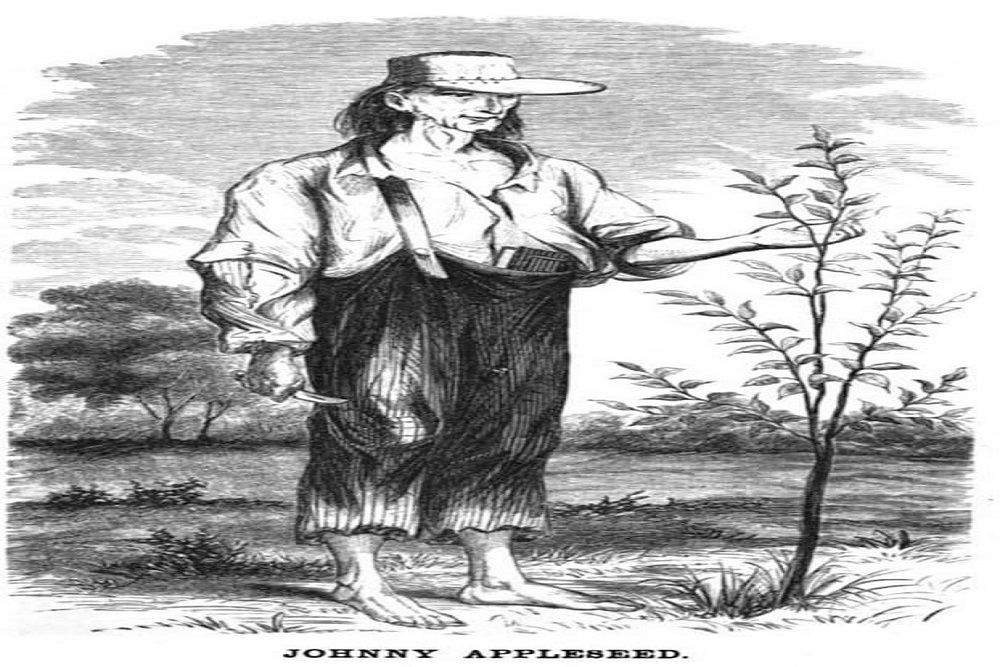The Removal of the Tribes from Greentown, and Johnny Appleseed’s Unsuccessful Attempt to Save Greentown, and the Copus, Seymour, and Ruffner Families
By Kenneth Hammontree
In our previous article on the removal of the tribes from Greentown, Ohio in the fall of 1812, we did not mention that Johnny Appleseed, aka John Chapman, as he was known then, also tried to intercede along with Rev. Copus and Peter Kinney, on behalf of the tribes at Greentown with Captain Douglas. John Chapman had been an emissary between the white settlers in the surrounding forest and the Greentown tribes, for at least two years prior to the destruction of the village, and removal of the tribes to the reservation (interment camp) at Piqua.
Chapman had arrived in the Richland/Ashland county area around 1810, from Mount Vernon, Ohio. He had a very large apple orchard along Owl Creek, outside the village, and worked with the local Delaware Tribes in assisting in the care of the orchard. John Chapman’s humanitarianism bonded him with the various tribes in the area, as his apple orchards spread to the Richland/Ashland counties.
Chapman spent many hours in Greentown working and supporting the various tribes living there. It was also during this time Chapman made friends with the local settlers, Copus, Seymour, Ruffner, Lambright, Kinney, Coulter and the Hill families.
Chapman loved all he came into contact with and lived by the Swedenborg faith of treating all humans the same knowing all are created in the image of God. Chapman visited every wilderness cabin religiously, feeling that he had been commissioned to preach, serve and read the good book to them since many could not read or write.
The Native American tribes in 1812 outnumbered the settlers in the Ashland/Richland area. Mansfield contained only a few cabins and its two blockhouses were still under construction in the spring/summer of 1812. The other blockhouse was at Beam’s Mill miles away on the Rocky Fork creek.
The settlers felt uneasy as news of the Shawnee War chief Tecumseh had called for all Tribes to arise against the settlers and take back their land and culture across the old Northwest territory.
Chapman, in his daily travels began hearing rumors among the tribes at Greentown and Jerometown that many of the young braves were leaving and joining up with Tecumseh and the prophet. He knew trouble was gathering momentum across the forest and he needed to warn the settlers in the area.
Chapman was torn between his close relationship with the Indians and his white friends.
He urged the settlers in the village of Mansfield to complete the block houses as soon as possible, and remain close to them. Then Chapman traveled to the outlying cabins in the dense woods east and south of Mansfield to warn them of possible danger. He pleaded with them to be alert and make their way to the several Block houses if they believe danger is close.
One of the furthest settlers North West of Mansfield was a family by the name of Reads, Hanson Reads had a large family as all settlers did, and asked Chapman to let him know how things were going in the war.
One day, in mid-August, Hanson was out in the thick woods looking for some cows and pigs that had wandered to far from the cabin barn, when Chapman appeared in a clearing, shouting, “Fly for your lives, the Canadians and Indians have landed at the village of Huron on Lake of the Cats (Erie).” The Reads packed up immediately, hid their iron ware in the woods and started for the block house in Mansfield. Chapman continued stopping at every cabin door to warn of danger in the wilderness. However, it turned out that the British and the Indians were not coming south after all, but followed the Lake of the Cats, to Sandusky.
The Reads lived in one of the Block houses in Mansfield until January, and then returned to their cabin. Chapman warned all the cabins he was aware of close to Greentown to move to the Block houses in Mansfield, however, many felt, including Reverend Copus, that Chapman was over reacting and stayed.
Nevertheless, as the rumors began to spread, many of the settlers by early September finally moved to Mansfield including Rev. Copus and his family, fearing an uprising and wanted someone to travel to Mt. Vernon and bring back soldiers to protect their families. No one volunteered to go the 26 miles on the newly-cut road through a dangerous forest to the fort.
John Chapman said he would go, knowing the Indians respected him, and that he would be safe in the forest. When he reached the fort outside of Mt. Vernon, Captain Douglas mustered as many men as he could and left orders for the rest to follow later. He took up the line of march about three o’clock in the morning and reached Mansfield about ten am.
Later, Johnny Chapman regretted that he brought Captain Douglas to Mansfield. He felt even worse after trying to persuade, along with Rev. Copus and Kenney, for Captain Douglas to leave Greentown alone. He flailed in all accounts. The settlers lost families and friends, John Chapman lost good friends and soldiers died. However, the greatest loss were, once again, the Native American tribes.
After the removal from Greentown, Chief Armstrong left the interment camp at Piqua, along with a few others and settled in Upper Sandusky never to return to Greentown. By 1815 most of the tribes were gone in the Richland/Ashland area, and by 1820, John Chapman had moved on claiming the area was becoming over crowded.
In our next article, we will learn if the Trail of Tears and the Indian Removal Act of 1830.
Original source found here.


 Alerts Sign-up
Alerts Sign-up